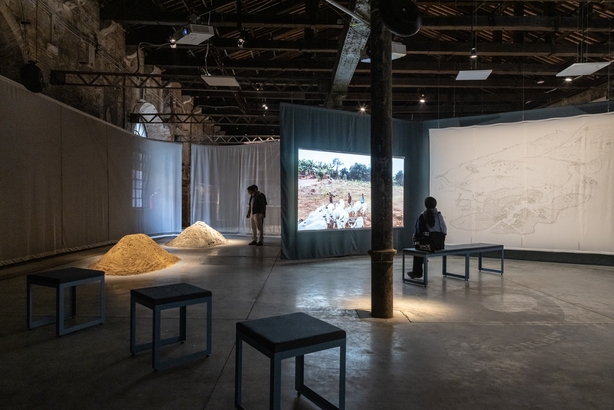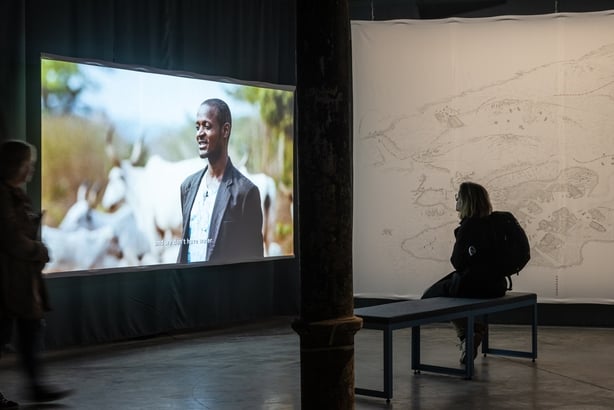Biennales, as we know them, were born in Venice 130 years ago. The original intention was to celebrate national artistic talent, with the Architecture Biennale emerging in the 1970s. In addition to growing in size, the Venice Architecture Biennale, such as with the discipline itself, has extended thematically since then to include contemporary political, cultural, and social issues.
This year's six-part exhibition, The Laboratory of the Future, set by the Biennale curator Lesley Lokko, includes 89 independent exhibitors from 64 nations, over half of whom are from Africa or the African Diaspora. Lokko wished to complete the story of architecture today by giving a voice to the people of Africa or African descent that straddles the globe.
How we began @la_Biennale @culture_ireland @artscouncil_ie @followtheboats @Seaniesan 📸 A2 pic.twitter.com/gO1FvIEXfo
— In Search of Hy-Brasil (@Hy_Brasil_Irl) June 14, 2023
Although national pavilions are not obliged to take on the year’s theme of decolonisation and decarbonisation, the Irish Pavilion, understandably and boldly, chose to do so.
On the afternoon of Friday 19 May, a crowd gathered in a dimly-lit room for the official launch of In Search of Hy-Brasil, Ireland’s national pavilion curated by Peter Cody, Peter Carroll, Elizabeth Hatz, Mary Laheen, and Joseph Mackey.
As if entering a cottage from a bygone time, their eyes had to adjust to the darkness after the Venetian daylight. Minister Patrick O’Donovan, with responsibility for the Gaeltacht, reminded us how our colonised past is embodied in our language, with a speech flowing from Irish to English. The words as Gaeilge were not a duplication of his English speech, but rather untranslatable sentiments and observations. So, too, the installation is a translation of perception; Ireland presenting itself on the world’s stage, but also back to an audience at home.
Are architecture biennales necessary in this digital age?
In the centre of the high-ceilinged room is a curious dark mound, 800kg of raw, unwashed black sheep's wool forming an abstracted island of Sceil Mhicíl topped with a clay model of a monastery, scale 1:100 underneath one of the two sources of artificial light. The other model in the room is by the exit from the Arsenale, a stone stack representing Ireland’s exclusive economic zone, with an area of 880,000km2. The curatorial team point out that at its current value of 15c per kg, sheep’s wool is vastly undervalued for its properties in a decarbonising world.
On the wall is a drawing of Pangaea, meaning ‘all water’, from a time when all continents as we know them formed a single continental mass. We were all one island. On the opposite wall, a pencil-drawing on vellum of the sea bed of Ireland’s maritime zone. A timely work of art, as Ireland sets a target of 7GW of offshore wind energy by 2030. On the floor, there are three limestone slabs from Inis Meáin pockmarked by fossils formed by the remains of marine life from the time of Pangaea, which have the seabed of Inis mean, Sceilg Mhicil and Clare Island etched on them.

My highlight from the launch was Elizabeth Hatz leaning over the slabs to bathe them to reveal the stories of the stone. She explained that invigilators’ daily rituals would include dousing these ancient slabs. A controversial move for the curators was being the only pavilion not to have the Italian information boards translated into English but rather into Irish, but I think it subtlety demonstrates the point of the pavilion. The room is completed with a filmscape/soundscape capturing a day in the life of Inis Meáin made by Red Pepper Productions. Weary visitors have an opportunity to rest on the sea sacks lining two sides of the room made from 65 metres of found sea rope stuffed with sheep’s wool.
The waters of the Greater Skellig Coast are home to important seabed features such as maerl and zostera beds @la_Biennale @culture_ireland @artscouncil_ie @countykerry 📸 Brian O'Curnáin, Invigilator pic.twitter.com/5BVnIEKdwM
— In Search of Hy-Brasil (@Hy_Brasil_Irl) June 13, 2023
The Landscape Rehearsals by BothAnd Group is the Irish exhibit also within the Arsenale invited by this year’s Biennale curator Lesley Lokko to respond to her theme. BothAnd Group is an architectural collective formed in 2019 by four TU Dublin graduates: Jarek Adamczuk, Alice Clarke, Andrew Ó Murchú and Kate Rushe. These young architects present us with the indigenous practices of roinn dáil land management and social organisation that we lost over the centuries. ‘As Britain’s first colony – and therefore, a first frontier of capitalism – the Irish landscape acted as a stage or ‘dress rehearsal for the reshaping of the world’, Alice Clarke explained, quoting David Harding.
In their research BothAnd Group could not source a representation of this land management practice so they pieced together their own drawing from oral histories. Interwoven in the drawing are Irish phrases following the contours of the landscape. Roinn dáil was an egalitarian way of allocating land to families dependent on their numbers, plus crop rotation to maintain land fertility and seasonal growth production governed by animal grazing patterns.

The lead collaborator for the installation is Nigerian landscape architect Gbogboade Seun. If Ireland was the dress rehearsal, Nigeria is one of the latest frontiers of industrialised, neo-colonialist agriculture, where indigenous land management traditions are under serious threat. These parallels are demonstrated in the short exhibition film, which follows Seun’s advocacy work to protect these vulnerable farming practices in Nigeria’s Ogun State. A second film is projected on to a mound of soil of indigenous farming practices of iroro and makiyaya.
Aside from the parallels, however, Ireland is no longer an innocent bystander, as Nigerian farmers being unable to compete with intensively produced Irish food exports being sold into the Nigeria at cheap prices.
Sea sack hues @la_Biennale @culture_ireland @artscouncil_ie 📸 Ste Murray pic.twitter.com/gL2uCK2Baj
— In Search of Hy-Brasil (@Hy_Brasil_Irl) June 13, 2023
Are architecture biennales necessary in this digital age? It’s a difficult question, particularly considering issues such as the carbon footprint of transporting pavilions and people. Lokko refreshingly addresses this elephant in the room in her introduction to the Biennale, stressing that an architecture exhibition is more than the sum of its parts but rather a ‘moment and a process’. Notwithstanding this conundrum, I still think there’s value in Ireland having an opportunity to present its current architectural research on an international stage. Moreover, bringing these installations back for public display in Ireland has the potential to pose timely questions. Neither ‘In Search of Hy-Brasil’ nor ‘Landscape Rehearsals’ provide answers, but instead pose questions. Discussions of loss of cultural identity and our relationship with land can, at times, get heated but what both exhibitions have done is create a safe space for these inquiries on neutral ground; the kind of terrain we need to value.
In Search of Hy-Brasil is supported by Culture Ireland and runs at The Venice Biennale until Sunday 26 November 2023 - find out more here.
Images: Ste Murray


